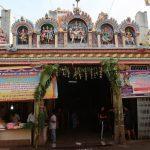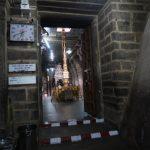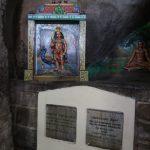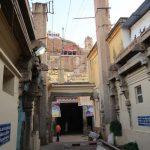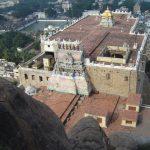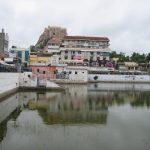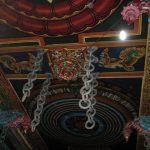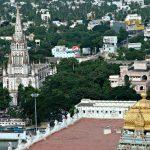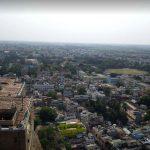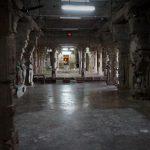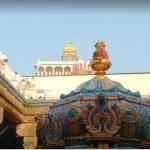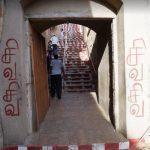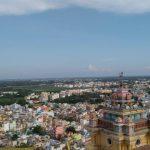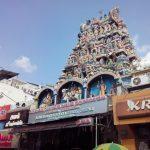Contents
Thayumanaswami Temple, Rockfort, Trichy
| Date built: | – |
|---|---|
| Deity: | Thayumanaswami |
| Architectural style: | Dravidian architecture |
| Major festivals | |
| Locale: | Rockfort |
| District:: | Trichy |
| Address: | Thayumanavar Temple,Rock Fort, Trichy – 620 002 |
| Phone | +91 431 270 4621 / 271 0484 / 270 0971 |
The Rockfort is a fortress which stands atop a 273-foot-high rock, consisting of a set of monolithic rocks accommodating many rock-cut cave temples. Originally built by the Pallavas, it was later reconstructed by the Madurai Nayaks and Vijayanagara rulers. The major complex in the temple are believed to be built during the 8th century by the Pandyan Empire. According to geologists, this Rocky Mountains dates back to 3500 billion years old. This place was also known as Sirappalli, Rishabachalam & Dhakshina Kailasam during ancient days.
Thirugnana Sambandar, a 7th century Tamil Saivite poet, venerated Thayumanavar in eleven verses in Thevaram, compiled as the First Thirumurai. Appar, a contemporary of Sambandar, also venerated Thayumanavar in 10 verses in Thevaram, compiled as the Fifth Thirumurai. As the temple is revered in Thevaram, it is classified as Paadal Petra Sthalam, one of the 276 temples that find mention in the Saiva canon. Muthukumaraswamy in the temple is revered in Thirupugazh, the hymns of Arunagirinathar, a 15th-century saint. This is the 123rd Devaram Paadal Petra Shiva Sthalams and 6th Shiva Sthalam located on the southern bank of River Cauvery in Chozha Naadu.
Pujas are conducted under two codes – Shivagama and Kameekam. The temple has six daily rituals at various times from 5:30 a.m. to 10 p.m., and twelve yearly festivals on its calendar. The Chittirai festival during the Tamil month of Chittirai (April – May) is celebrated for fifteen days, portraying the various incidents associated with the temple legend. The temple is maintained and administered by the Hindu Religious and Endowment Board of the Government of Tamil Nadu.
Temple Opening Time
The temple is open from 6.00 a.m. to 12.00 a.m. and from 4.00 p.m. to 8.30 p.m.
Festivals
The temple priests perform the pooja (rituals) during festivals and on a daily basis. Like other Shiva temples of Tamil Nadu, the priests belong to the Shaivite community, a Brahmin sub-caste. The temple rituals are performed six times a day; Ushathkalam at 5:30 a.m., Kalasanthi at 8:00 a.m., Uchikalam at 10:00 a.m., Sayarakshai at 6:00 p.m., Irandamkalam at 8:00 p.m. and Ardha Jamam at 10:00 p.m. Each ritual comprises four steps: abhisheka (sacred bath), alangaram(decoration), neivethanam (food offering) and deepa aradanai (waving of lamps) for both Thayumanaswami and Mattuvar Kuzhal Amman.
The worship is held amidst music with nagaswaram (pipe instrument) and tavil (percussion instrument), religious instructions in the Vedas read by priests and prostration by worshippers in front of the temple mast. There are weekly rituals like somavaram and sukravaram, fortnightly rituals like Pradosham and monthly festivals like Ammavasai (new moon day), kiruthigai, Pournami (full moon day) and Sathurthi.
The temple celebrates dozens of festivals throughout the year. The Chittirai festival during the Tamil month of Chittirai (April – May) is celebrated for fifteen days, portraying the various incidents associated with the temple legend. The car festival is held on the ninth day, when the processional deities of Thayumanaswami and Mattuvar Kuzhalammai are taken out in separate chariots around the temple in NSB Road, Nandikovil Street, North and East Andar streets and the Malaivasal.
The event of Lord Shiva servicing Rathnavathi during her labour moments is celebrated on the 5th day of Chithirai Brahmmotsavam in April-May. Curtain is downed during this event. They decorate Rathnavathi with child on her lap. The curtain is then lifted for darshan offering light puja- Deepa Aaradhana. After the puja, the oil and the maternity medicine given to mothers after delivery are given to the devotees as Prasad. It is believed that pregnant women consuming this will be blessed with safe delivery.
The Karthigai festival is celebrated during the Tamil month of Karthikai, between November and December, concluding with the celebration of Karthikai Deepam. A huge lamp is lit in a cauldron, containing three tons of ghee, at the top of the Malai Kottai hills during the Deepam. To mark the occasion, the festival deity of Thayumanaswami circumambulates the mountain.
Every full moon, tens of thousands of pilgrims worship Thayumanaswami by circumambulating the Tiruchirappalli hill barefoot. The circumambulation covers the circumference around the hill, and is referred as Girivalam. On the day of yearly Chitra Pournami, the full moon of the Tamil calendar, hundreds of thousands of pilgrims come from across the world to worship Thayumanaswami.
Thayumanavar Guru Puja is celebrated in the month of Thai (January-February) on the day that the star Visakam reigns. Lord Shiva is brought in a procession on the first day of every Tamil month and on new moon days. Lord Shiva as a Swayambulinga graces devotees facing west. The rays of the sun fall on the Lord for three days in the evenings in the month of Panguni (March-April). The float festival also takes place during this period. Pujas are conducted under two codes – Shivagama and Kameekam.
Chithirai Brahmmotsavam in April-May; Panguni float festival in March-April; Aadi Pooram in July-August; Aipasi Annabishekam in October-November; Tirukarthikai in November-December; Panchamurthy procession on Makar Sankranti (Thai Pongal) falling almost on January 14 and Maha Shivarathri in February-March are the festivals celebrated in the temple.
Architecture
Legend / Local stories
Thayumanavar:
According to Hindu legend, a pregnant woman named Rathnavathi was an ardent devotee of Shiva. While nearing labor, she requested her mother to come over. Her mom could not reach on account of heavy floods in river Cauvery. As delivery time came closer, Rathnavathi prayed to Shiva. Shiva, moved by the devotion of Rathnavathi, took the form of Rathnavathi’s mother and helped with her smooth delivery. After the delivery, Shiva vanished and Rathnavathi’s mother who arrived later. The family came to know that it was Shiva who attended to the delivery.
Henceforth, Shiva in the temple came to known as Thayumanaswami, meaning the Lord who could act like a Mother. The temple obtained the name from the presiding deity, Thayumanaswami. Shiva disguised himself as a mother for a pregnant lady, leading to the name Thayumanavar, meaning the one who became a mother. This incident is also celebrated as a special event called “Chettipenn Maruthuvam” on the fifth day of the Chithirai Festival at the temple.
Tirishiramalai:
According to Hindu mythology, the city Tiruchirappalli derives its name from legend associated with the Thayumanaswami Temple. Demon Tirishira (demon with three heads) was on penance on Lord Shiva. Though many years passed, Lord Shiva delayed his darshan to test his purity. He threw two of his heads in fire and was about to throw the third, Lord appeared before him and restored his two heads. As requested by him, Lord Shiva agreed to stay here in the name of Thirisira Nathar (based on demon Tirishira story). The place came to be known as Tirishiramalai, now changed as Trichy.
Lord Shiva caused Sand Rain to punish Chola King:
The region was ruled by a Chola king having Woraiyur as his capital. During this time, Sarama Munivar created a flower garden here and was worshipping Lord with Sevvanthi flowers. A trader stole the flowers from this garden and gave them to the king. As the king became very fond of these flowers, he asked the trader to supply them to him daily. The trader continued his theft business. This caused disturbance to the Shiva Puja of Sarama Munivar. His appeal to the king was in vain. Munivar appealed to Lord Shiva who looked at the direction of the court of the king and caused sand rain in the place. The king realized his wrong doing, prayed to Lord Shiva and was pardoned.
Contest between Adisesha and Vayu:
A furious contest arose between Adisesha and Vayu to decide the supremacy of their prowess. The condition was to shake violently Mount Kailash. Defeating Adisesha, when Vayu broke the mount, the top of the Kailasam was disturbed by Vayu (air) and thrown in three places and this is considered one among them and that is why this is called Dakshina Kailasam. The other two places are Kalahasthi and Tirikonamalai (Srilanka).
Shrine turned west from east:
The shrine was previously facing east. As Lord turned west to punish the king who stole the Sevvanthi flowers and caused disturbance to the puja of Sarama Munivar, the shrine stood permanently facing west leaving the flag post behind. During the puja times, the music and Thevaram recitals are followed only from eastern side behind the shrine.
Kediliappa Pillai named his son after the Lord:
One Kediliappa Pillai was the treasurer – accountant of King Vijaya Raghunatha Chokkar during his rule of the region. Pillai was a staunch Shiva devotee and was gifted with a handsome son. Pillai named him Thayumanavar after the name of the Lord. The boy showed all signs of brilliance in education and characters. The king retained him in his services. He served the king for a long time, while his heart was with the Lord.
People worshipped Lord Shiva here:
Sage Agasthya, Arjuna, Hanuman, Rathnavathi, Rama, Saptha Kanniar (seven virgins) and Saptha Rishis (seven sages) are supposed to have worshipped Shiva in this place.
Sevvanthi Nathar:
Sarama muni (sage) worshipped Shiva with Sevvanthi flowers (chrysanthemums) brought from Nagaloka, the abode of the Nagas or serpents. So, the Lord is called Sevvanthi Nathar.
Thiri Sikarapuram:
There are also stories that since there are three peaks on Rock Fort, occupied by three Gods Shiva, Parvathi & Vinayakar (Uchi Pillaiyar), the place was called Thiri-sikarapuram and later called Tirisirapuram.
Photo Gallery
How to Reach:
The temple is located halfway up the Rockfort Temple Complex. Rockfort is located at about 5 Kms from Trichy Central Bus Stand, 1.5 Kms from Chatiram Bus Station, 5 Kms from Trichy Railway Station, 4 Kms from Woraiyur, 14 Kms from Thiruverumbur, 4 Kms from Srirangam, 7 Kms from Thiruvanaikoil, 6 Kms from Trichy and 10 Kms from Trichy International Airport. Lots of buses ply from both Central & Chathram bus stands of Trichy. One can get down at Main Guard Gate or Teppakulam to reach Rockfort.
Contact Details
Thayumanavar Temple,
Rock Fort, Trichy – 620 002
Phone: +91 431 270 4621 / 271 0484 / 270 0971
Email: thiruchyrockforttemple@gmail.com


